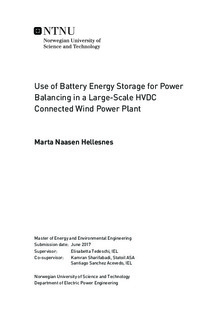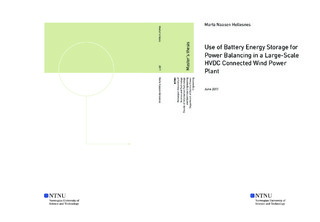| dc.description.abstract | The increasing implementation of intermittent renewable energy sources into the power system brings challenges in terms of grid stability, power quality and security of supply. Traditionally, rotating reserves and thermal power plants based on fossil fuels have been used to provide balancing services in the grid, but due to an increased focus on sustainable solutions and increasingly demanding climate goals, more environmental friendly solutions must be considered. The main objective of this thesis is to study how battery energy storage can be used to provide the ancillary services of primary and secondary reserves to the grid, in order to help stabilize the grid and support integration of large scale offshore wind power.
The system studied in this project consists of an offshore wind farm connected to the grid onshore via a high voltage direct current (HVDC) transmission system. Battery energy storage is connected through a DC/DC converter to the DC-link of the HVDC system. The main focus of the work is related to the battery and the DC/DC converter. A number of battery technologies and DC/DC converter topologies have been studied. It is found that for the application in this project the lithium-ion (Li-ion) battery is the optimal choice of battery storage technology. The optimal DC/DC converter is found to be a galvanically bidirectional converter consisting of a modular multilevel converter (MMC) on the high voltage side and a two-level voltage source converter (2L-VSC) on the low voltage side of the medium frequency coupling transformer, which provides the galvanic isolation.
The scope of the thesis consists of two main parts; a design part and a simulation part. In the design part, the design of the different components of the system are discussed in terms of voltage levels, power ratings, number of components, type of components, size and cost. The battery is designed based on ABB's EssPro Grid battery modules and an optimal design for the application in this project in terms of series and parallel connections of battery modules, is proposed. In terms of semiconductor devices for the DC/DC converter, it is found that the insulated-gate bipolar transistor (IGBT) press-pack devices are preferred over the integrated gate-commutated thyristor (IGCT) for both the MMC and the 2L-VSC for the converter design in this project. It is also found that for the galvanic isolation of the DC/DC converter, the optimal choice is to have a medium frequency transformer with a frequency of 300 Hz and a turns ratio of 1:3.
In the simulation part of the scope simulation models of the different parts of the system are developed. The models are implemented in MATLAB and Simulink. The different parts are modeled and verified separately before the final system is created by connecting the different parts. Two simulation cases are performed. In the first case a simulation of the DC/DC converter and the battery is performed. The power flow is controlled to be both positive and negative to verify that the converter provides bidirectional power flow so that the battery can be charged and discharged, depending on the state of charge (SOC). A battery SOC model has been included in the 2L-VSC model in order to verify that the battery is charging and discharging. The results show that the battery can be charged and discharged and that the proposed DC/DC converter provides bidirectional power flow.
The second simulation case also includes the simulation model of the HVDC transmission system, the offshore wind farm and the grid onshore. In this case the power flow of the HVDC system and the DC/DC converter is controlled so that when the wind power generation increases above the constant power consumption onshore of 0.82 pu, the battery system will charge, and when the wind power generation decreases below 0.82 pu, the battery system will discharge, in order to provide a constant power flow of 0.82 pu to the grid onshore. This is simulated to verify that the battery storage can provide balancing services in order to stabilize the grid and support integration of offshore wind power into the power system. The results show that the battery helps stabilize the grid by providing constant power flow to the onshore grid by charging in times when the wind power generation is higher than the power consumption onshore, and by discharging in times when the wind power generation is lower than the power consumption.
At the end of the thesis the results of the second simulation case is compared to the same simulation case of a similar system, where the battery storage is connected to the onshore AC-side through an MMC and a transformer. The results show that both DC-side and AC-side connection of the battery storage are possible, and in both cases the battery storage can stabilize the grid and support integration of offshore wind power into the power system. | |

